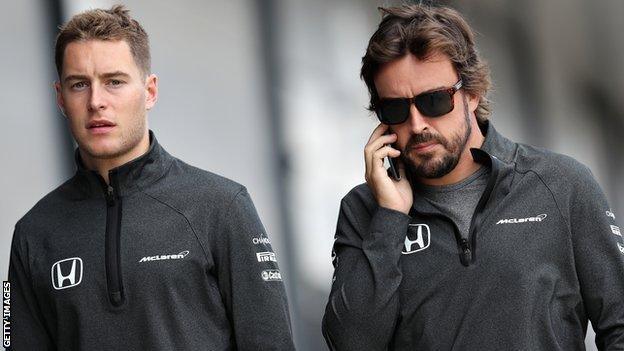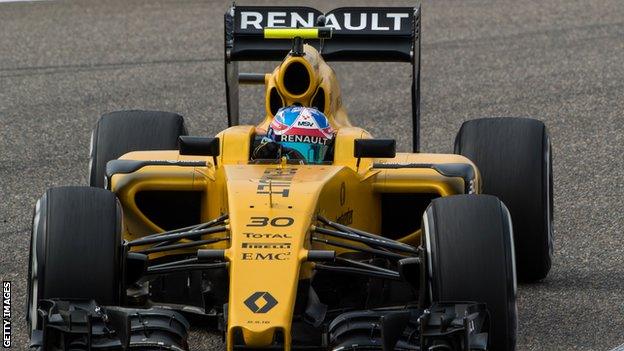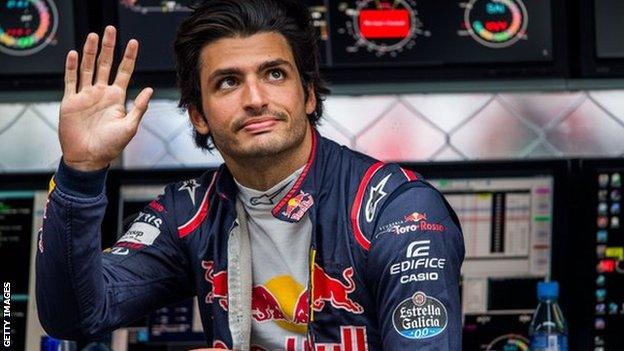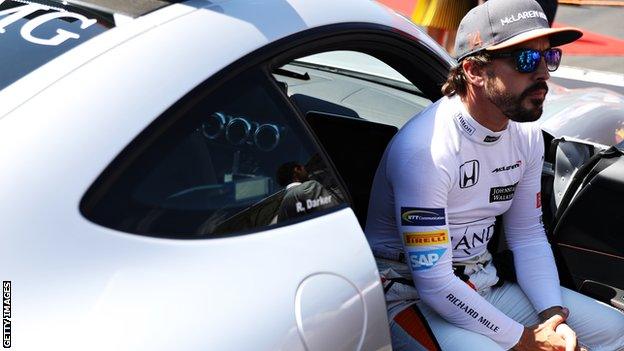McLaren-Honda: Handled well, a split could be good for teams, drivers and F1
- Published
- comments

Fernando Alonso (right, pictured with fellow McLaren driver Stoffel Vandoorne) is more likely to stay in F1 if the partnership with Honda ends
The long-running saga over McLaren's partnership with Honda appears to be coming to an end.
The team look to be on the brink of a divorce from the Japanese company, three disappointing years into a partnership that had been intended to last a decade or more and dominate Formula 1.
Instead, Honda's failure to produce an engine that was either reliable enough or had sufficient performance to be anywhere near competitive has convinced McLaren they need to split - and a deal to use Renault customer engines for the next three years is believed to be in the offing.
The history of the split - 'an epic palaver'
It is a complicated scenario that has its origins back in March, and it also involves the future of one of F1's biggest stars - Fernando Alonso - and one of its brightest up-and-coming talents, Carlos Sainz.
McLaren's search for a way out of its Honda contract has been such an epic palaver that it would be wise to take nothing for granted until a split is formally confirmed.
But all the signs are that the endgame is close.
Splitting with Honda is a calculated gamble for McLaren. The Japanese car company's involvement with the team provides a net financial gain of about $100m (£76m) as a result of a supply of free engines, sponsorship contributions and Honda paying half the drivers' salaries.
But Honda's performance and reliability has been so abject in recent years that McLaren felt it had no choice but to file for divorce.
Honda was cut some slack in its first season because it had come to the current F1 engine formula, which involves incredibly complex turbo hybrid engines, later than its rivals Mercedes, Ferrari and Renault.
Last year, there were signs of improvement, even if Honda remained a long way down on power. But this year has marked a backward step.
McLaren believe the engine remains in the region of 80bhp down on a customer Mercedes and its reliability has been shocking - Alonso and team-mate Stoffel Vandoorne have between them racked up a total of 260 grid penalties for using more than the permitted number of engines, and more are inevitable. As a comparison, across three teams Renault have had 105, and there have been none at all for a Mercedes- or Ferrari-engined car yet.
McLaren management came to the conclusion that their relationship with Honda was inflicting such damage that it was putting the future of the team at risk.
Prize money - awarded on the basis of constructors' championship positions - was dropping. Attracting sponsors was proving next to impossible. And no top driver would be interested in driving for them. Alonso, for one, had completely lost faith in Honda - as the company's own F1 boss admitted at the Belgian Grand Prix last month.

Renault appear to have agreed a deal with McLaren, despite initial misgivings over the implications for their own team
McLaren's first choice was Mercedes - but after the bosses of the two companies appeared to reach an agreement back in April, that deal collapsed. Ferrari effectively also said no, and that left Renault.
The French engine is only the third best out of the four engines in F1 but McLaren believe it still represents a significant step forward over the Honda - of somewhere in the region of 45-60bhp - and a deal appears to have been secured.
For McLaren, it's about getting themselves back into a relatively competitive position for the next three years until a new engine formula comes in for 2021. Then, all sorts of possibilities could open up, including perhaps even making their own engine.
The complexities - and Toro Rosso
McLaren's problem was that Honda did not want to split with them, and the bosses of F1 were very keen to keep the company in the sport - both governing body the FIA and the new owners of the commercial arm Formula 1 Management. Both have been involved in working out a resolution that was satisfactory to all parties.
An added complication was that Renault were uncomfortable about supplying four teams, feeling that would affect their performance next year, when they hope to close the gap to Mercedes and Ferrari. Nor could Renault afford to harm their own factory team - the primary reason they are in F1.
To their credit, Renault appears to have decided to supply McLaren even though there is a very real risk that it will mean the factory team being beaten by two teams with their own engine, rather than just Red Bull this year.
The McLaren appears to be a better chassis than the Renault, judging by the relative performance of the respective cars and the known power offset of their engines. In addition, in Red Bull drivers Max Verstappen and Daniel Ricciardo and McLaren's Alonso it will mean at least three drivers better than Renault's own, even if the cars were equal.
So it says a lot for Renault's commitment to F1 and sense of sportsmanship that they are prepared to go for it.
But they still needed to resolve the four-engine conundrum. And that's where Red Bull come in.
They were keen to have an involvement with Honda and agreed to an effective engine swap between their junior team Toro Rosso, who this year use Renault, and McLaren.
This worked for Red Bull, who could see the benefit in starting a relationship with Honda - the idea being to park the engines in the second team while the manufacturer sorted themselves out, and then once the engine was competitive switch it to the senior team and become Honda's factory partner.
The drivers' role

Carlos Sainz could leave Toro Rosso for Renault as part of the complex negotiations
There was another issue. Renault had identified Toro Rosso's Sainz as the driver they wanted for 2018 alongside German Nico Hulkenberg.
Sainz, too, was keen, feeling it was time to move on from Toro Rosso after three years, but with no opening yet at Red Bull, where Ricciardo and Verstappen are locked in until at least the end of 2018.
The problem was the Spaniard was under contract to Red Bull - they took up his option back in June.
So the 23-year-old became a bargaining chip in the wider game and it seems that, eventually, Red Bull have agreed to release him to drive for Renault. The quid pro quo is said to be Renault not making a fuss about Red Bull breaking their engine contract.
In addition, Renault were as keen to be involved with McLaren, as long as it was do-able, as McLaren were with them.
All of this, of course, is bad news for Englishman Jolyon Palmer, who would appear to be out of a drive at the end of this season.
Alonso set to stay in F1

Alonso had dropped hints about his unhappiness with Honda and could have been set for a year in IndyCars
McLaren dropping Honda and securing Renault - assuming it happens - is almost certainly going to mean that Alonso will stay in F1.
Had McLaren stayed with Honda, it is widely believed the Spaniard would have left, unable to stomach the prospect of another season as bad as the past three. In that scenario, a year in IndyCars was his only realistic option for a competitive car somewhere.
Alonso has denied that he offered McLaren an ultimatum - "get rid of Honda or I'm off" - but he has also dropped a number of hints about the way he was thinking, including saying about the Honda v Renault option: "I don't think there is any tough choice."
Alonso believes that with a Renault engine, he and McLaren can be battling with Red Bull next season, which means top six on the grid and podiums, perhaps even the occasional win in freak circumstances - such as Ricciardo's in Azerbaijan this season.
And if Renault improve as much as they hope over the winter, perhaps even more will be possible.
All of that is predicated on the assumption that the McLaren chassis is as good as the team think it is.
Their confidence is based on the cornering speeds they see from the car before the lack of Honda power comes into effect on the straight - and the car's performance profile from track to track backs them up.
Alonso achieved their best result of the season in Hungary, for example, qualifying eighth and finishing sixth on a track where engine power is not so important, only to be passed like he was standing still on the long straights of Belgium after a brilliant start had him up to seventh on the first lap. They are expecting another relatively competitive performance in Singapore this weekend.
But there are those in F1 who question this. Some say it's possible the McLaren's good cornering speeds are achieved by running more downforce than other cars, and that one consequence of this is that the car is slow on the straight. In other words, perhaps the car is not as good and the Honda engine not as bad as most assume.
Only time will tell. But for now all fans of F1 can be pleased that the career of one of its greatest drivers is at least going to get another chance to end on a relative high, rather than fizzling out in the depressing manner it appeared it might.
A final thought
Assuming all this happens, all those involved can pat themselves on the back after achieving a solution that is genuinely good for all concerned - and the sport itself.
A great team and its great driver - McLaren and Alonso - can look forward to a brighter future. A rising star - Sainz - gets the move he deserves to a higher-profile team.
Another great team - Red Bull - has the potential for a works engine partnership after years of frustration. And Honda, one of the world's most iconic car companies, is not only kept in F1, but given the opportunity to sort itself out away from the glare of the spotlight created by being with Alonso and McLaren.
For the bosses of McLaren, Renault, Red Bull, Honda, the FIA and F1 Management it would appear, after a long and drawn-out process, to be a job well done.